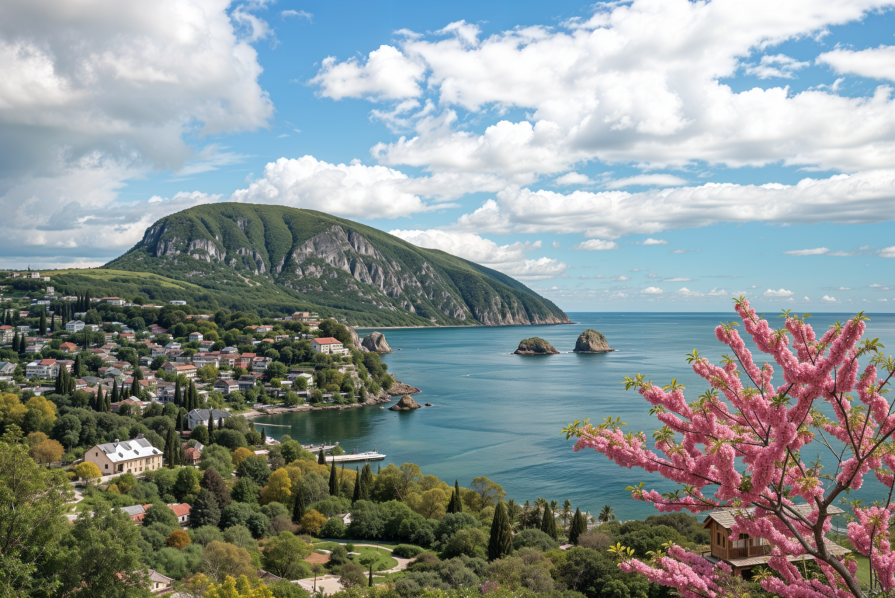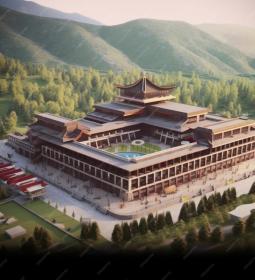Crimea is the cherished charm of Vladimir Putin. Whatever it was, this region remains the best in Russia in terms of tourist attractiveness due to its favorable location and excellent climate. On this small piece of land in the coastline there are more than half a thousand sanatorium-resort institutions and all kinds of hotels with hotels.
The sights of the region can be listed forever, but we will focus only on the largest and most famous of them. What if you still haven't learned them?
Swallow's Nest (Yalta)
Castle structure among the rocks on the South coast near the city. Combining elements of traditional oriental architecture with Gothic solutions, it crowns a forty-meter rock on Cape Ai-Todor. Built in the XIX century on the site of a small general's dacha, it underwent a total reconstruction in the 1910s, when it was bought by oil magnate von Steingel, a resident of Baku. In the 1960s, it was completely demolished and rebuilt, as the serious destruction of the earthquake of 1927 and the German occupation were not in vain for the foundation of the building.

Vorontsov Palace (Alupka)
Historical monument, "stuck" to the foot of the Taurida Mountains near Alupka. It is considered the oldest and most popular among tourists palace of the South Coast.
On the sea side is made in the Moorish style, and from the mountain - in a more calm, representative of the English neo-Gothic. 150 halls and galleries are available for inspection: the blue salon, the Chinese hall and the Library hall leave the most vivid impression. Everything is surrounded by a magnificent garden, whose project is made by the German landscape architect Karl Kebach.
Livadia Palace (Livadia village)
Favorite summer cottage of the last Russian tsar. Built in 1910-1912, it is best known as the stage for the most important political event in the history of the XX century: HERE met US President Franklin Delano Roosevelt, British Prime Minister Winston Churchill and Secretary General of the Central Committee of the CPSU (b) Joseph Stalin to determine the boundaries and rules of the game in post-war Europe.
Massandra Palace (Massandra village)
Ancient Greek settlement near Yalta. In 1783 it was bought by the daughter of the Polish pan Potocki, who in the first half of the XIX century built a castle here in the middle of a huge park. Then the possessions were bought by the Governor-General of Novorossiysk, and then fell into state ownership. In Soviet times – the state dacha of the Central Committee, Stalin's favorite place.
Khan's Palace Bakhchisaray (Bakhchisaray)

The first mentions belong to the XVI century. It was home to the Crimean khans, and became a national shrine of the Crimean Tatar people. Initially, Bakhchisarai - a garden palace - was called only the residence of the ruler, but later this name was also given to the town.
The most famous part of the interiors is the Fountain of Tears, made of a single block of marble and serving as a monument built by order of Kirim Giray in honor of his late wife Dilinar Bikic in the second half of the XVIII century. This place inspired Pushkin and Mickiewicz, as well as many others.
Church of the Resurrection of Christ (Foros village)
The architectural monument of the century before last was opened in 1892, the frescoes were made by the artists Makovsky and Korzukhin, and the mosaic panels by the Italian master Salviati. The construction was made in memory of the miraculous salvation of the royal family of Alexander III during the train crash to St. Petersburg.
In 1924 the church was closed, the frescoes were painted over, and the priests were exiled to Siberia to soon open a tavern in its place. Services were resumed after restoration in the 1990s.
Holy Dormition Monastery (Bakhchisaray)
Hidden in caves, the monastery is located in a narrow valley near the city. It was founded in the VIII century, and with the fall of the rule of the Byzantine basileus completely destroyed. The reopening took place in the XV century during the reign of Genoa, and then the Crimean khans.
During the Soviet era, it was abandoned and closed, but with the fall of the red empire, the monks returned here, the buildings were restored, and the icons made on the body of the rock were updated.
Nikitsky Botanical Garden (Nikita village)

The botanical garden sung by Andrei Makarevich was founded in the year of the beginning of the war with Napoleon. It is located 8 km east of Yalta: it is the home of 12 scientific organizations studying subtropical fauna and flora. There are more than 50 thousand plants, some roses more than 2 thousand. The institutes of the Garden house the world's greatest herbarium and the oldest library of botanical themes.
Bear-mountain, or Ayu-Dag (Yalta)
The mountain is just under 600 meters high between Gurzuf and Partenit. Outwardly resembles a bear, bent to the sea at a watering hole.
Archaeologists in the course of excavations managed to find here dated to the early Middle Ages dwellings and several churches, and at the dawn of the first millennium there was a Byzantine seaport.
Mount Ai-Petri (Miskhor village)
The much higher Ai-Petri is one of the recognized symbols of the peninsula. The geological origin differs from the volcanic Ayu-Dag: these are the corals of the Jurassic Sea, which rose from its waters along with the Crimean ridge.
For more than 40 years, a three-kilometer cable car connects the village and the observation deck on the top of the mountain.
Cave city Chufut-Kale (Bakhchisaray)

One of the three cities in the caves of the Crimean mountains along with Eski-Kermen and Mangup-Kale. It was founded in the VII century, then captured by the Tatars and turned into a fortress. At the end of the XIV century it was inhabited by Karaites and received the current name of the "Jewish fortress". He fell into desolation in the XVIII century.
Marble Cave (Marble Village)
One of the five most beautiful stalactite caves in the world was discovered in 1979 and is perfectly preserved. The visit depends on weather conditions and is possible only as part of tours.
Kizil-Koba Cave, or Red Cave
Located 10 km from the Marble Cave, one of the most popular attractions of the Crimea. The grandiose dungeon stretches for 25 kilometers. Well studied. 6 levels of different heights are punched by water in the limestone, and the color of the walls is due to the content of iron oxides.
Chersonesos Tauride (Sevastopol)

Ancient Chersonesos is the most important monument of Byzantium, the largest open-air museum of antiquity. Actively studied since the mid-1960s, it has become a kind of symbol of the era. World Heritage Site since 2013.
Genoese fortress (Sudak)
This place was founded by a tribe of nomadic Alans as a fortress in 212. Then here, replacing each other, lived the Greeks, Genoese, Venetians. It is well preserved, since in these places siege artillery was a rarity, and is considered a masterpiece of fortification art of Western Europe.
Walls up to 8 meters high and over two meters thick protect the top of the fortress hill. 12 towers, of which two are gate, are dated 1388-1392.









